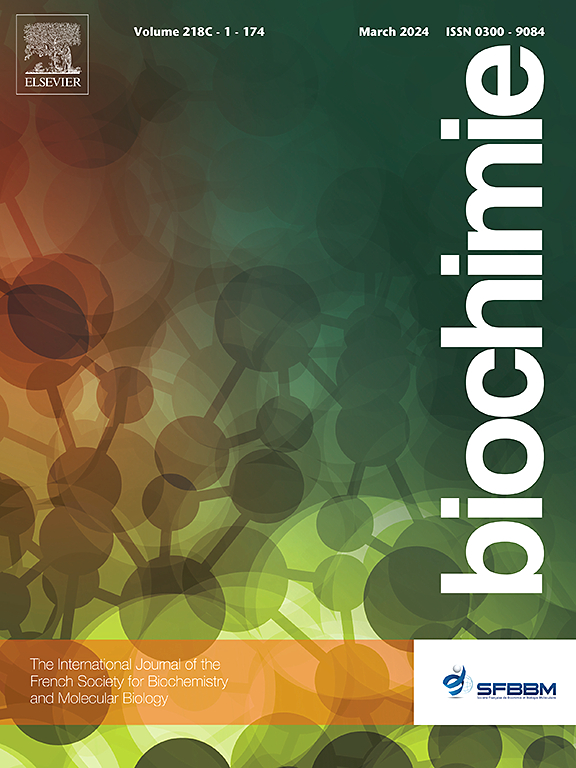基于转录组分析的解淀粉芽孢杆菌BB61还原亚硒酸盐的分子机制
IF 3.3
3区 生物学
Q2 BIOCHEMISTRY & MOLECULAR BIOLOGY
引用次数: 0
摘要
亚硒酸盐的微生物转化是一种有效的解毒和同化过程,但其基本机制仍不完全清楚。在本研究中,菌株 BB61 是一种从仔猪粪便中分离出来的益生菌,经鉴定为淀粉芽孢杆菌,它能在 48 小时内将 0.1 g/L Na2SeO3 几乎完全还原为 SeNPs。我们通过转录组测序和 qPCR 研究了该菌株还原亚硒酸盐的潜在机制。转录组分析表明,淀粉芽孢杆菌 BB61 对 1 g/L Se 处理有 829 个基因上调,892 个基因下调(padj < 0.05)。GO(基因本体)富集分析表明,DEGs(差异表达基因)主要与跨膜转运体、离子跨膜转运、细胞质和细胞膜组成、细胞运动和定位以及碳代谢有关。此外,KEGG(基因与基因组百科全书)通路注释分析显示,DEGs 主要参与磷酸戊糖通路、丙酮酸代谢、嘧啶代谢、辅助因子生物合成和其他通路(P < 0.05)。在高表达的还原酶中,硫氧还蛋白还原酶(TrxA/B)、亚硝酸盐还原酶(NfsA)和亚硒酸盐还原酶(NamA)均被上调。因此,本研究建立了 Se (IV) 的还原途径模型,为了解亚硒酸盐生物还原形成 SeNPs 的分子机制提供了新的视角。本文章由计算机程序翻译,如有差异,请以英文原文为准。

Molecular mechanism of selenite reduction by Bacillus amyloliquefaciens BB61 based on transcriptome analysis
The microbial conversion of selenite represents an effective detoxification and assimilation process, although the underlying mechanisms remain incompletely understood. In this study, strain BB61 was a probiotic isolated from piglet feces and identified as Bacillus amyloliquefaciens, which could almost completely reduce 0.1 g/L Na2SeO3 to SeNPs within 48h. We investigated the potential mechanisms of selenite reduction in this strain through transcriptome sequencing and qPCR. The transcriptome analysis revealed the up-regulation of 829 genes and the down-regulation of 892 genes in response to 1 g/L Se treatment (padj <0.05) in Bacillus amyloliquefaciens BB61. GO (Gene Ontology) enrichment analysis indicated that DEGs (Differentially expressed genes) were predominantly associated with transmembrane transporters, ion transmembrane transport, cytoplasmic and cell membrane composition, cell movement and localization, and carbon metabolism. Additionally, the KEGG (Encyclopedia of Genes and Genomes) pathway annotation analysis revealed that the DEGs were primarily involved in the pentose phosphate pathway, pyruvate metabolism, pyrimidine metabolism, cofactor biosynthesis, and other pathways (P < 0.05). Among the highly expressed reductases, thioredoxin reductase (TrxA/B), nitrite reductase (NfsA), and selenite reductase (NamA) were all found to be up-regulated. Consequently, this study established a reduction pathway model for Se (IV), offering new insights into the molecular mechanisms underlying the bioreduction of selenite to form SeNPs.
求助全文
通过发布文献求助,成功后即可免费获取论文全文。
去求助
来源期刊

Biochimie
生物-生化与分子生物学
CiteScore
7.20
自引率
2.60%
发文量
219
审稿时长
40 days
期刊介绍:
Biochimie publishes original research articles, short communications, review articles, graphical reviews, mini-reviews, and hypotheses in the broad areas of biology, including biochemistry, enzymology, molecular and cell biology, metabolic regulation, genetics, immunology, microbiology, structural biology, genomics, proteomics, and molecular mechanisms of disease. Biochimie publishes exclusively in English.
Articles are subject to peer review, and must satisfy the requirements of originality, high scientific integrity and general interest to a broad range of readers. Submissions that are judged to be of sound scientific and technical quality but do not fully satisfy the requirements for publication in Biochimie may benefit from a transfer service to a more suitable journal within the same subject area.
 求助内容:
求助内容: 应助结果提醒方式:
应助结果提醒方式:


